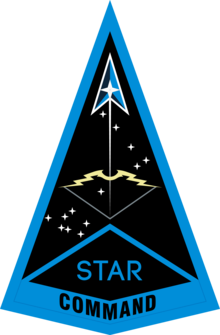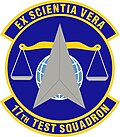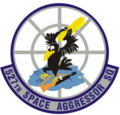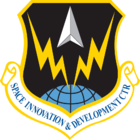| Space Training and Readiness Command | |
|---|---|
 Space Training and Readiness Command emblem Space Training and Readiness Command emblem | |
| Founded | 23 August 2021 (3 years, 4 months) as Space Training and Readiness Command 1 November 1993 (31 years, 2 months) as the Space Warfare Center |
| Country | |
| Branch | |
| Type | Field command |
| Role | |
| Size | 800 personnel |
| Headquarters | Peterson Space Force Base, Colorado, U.S. |
| Colors | Cannes Blue |
| Decorations | Air Force Organization Excellence Award |
| Website | www |
| Commanders | |
| Commander | |
| Deputy Commander | |
| Senior Enlisted Leader | CMSgt Karmann-Monique Pogue |
| Insignia | |
| Flag |  |
Space Training and Readiness Command (STAR Command or STARCOM) is the United States Space Force's education, training, doctrine, and test field command. It is headquartered at Peterson Space Force Base, Colorado.
Space Training and Readiness Command was first established on 1 November 1993 as the U.S. Air Force Space Warfare Center under Air Force Space Command and simply renamed to the Space Warfare Center (SWC) on 1 July 1994. On 1 March 2006, the Space Warfare Center was redesignated as the Space Innovation and Development Center (SIDC). The Space Innovation and Development Center was inactivated on 1 April 2013 and its responsibilities were transferred to Air Combat Command's United States Air Force Warfare Center. Following the establishment of the U.S. Space Force as an independent service, the Space Training and Readiness Delta (Provisional) was activated on 24 July 2020 under Space Operations Command to begin preparing the groundwork for STARCOM's activation as the Space Force's third field command on 23 August 2021.
History
Beginning as the Space Warfare Center
Space Warfare Center groups and squadrons-
 595th Space Group
595th Space Group
-
 3rd Space Experimentation Squadron
3rd Space Experimentation Squadron
-
 17th Test Squadron
17th Test Squadron
-
 25th Space Range Squadron
25th Space Range Squadron
-
 527th Space Aggressor Squadron
527th Space Aggressor Squadron
-
 576th Flight Test Squadron
576th Flight Test Squadron
-
 Air Force Space Battlelab
Air Force Space Battlelab
The U.S. Air Force Space Warfare Center (SWC) was established on 1 November 1993 at Falcon Air Force Base under Air Force Space Command to better enhance military space capabilities. On 1 July 1994, its name was simplified to the Space Warfare Center. The Space Warfare Center was created as a direct result of the Gulf War, where U.S. space capabilities were used more than any previous conflict, but post–war analysis indicated potential shortfalls.
The Space Warfare Center was specifically tasked with integrating space forces with terrestrial forces, including working with the Air Force Doctrine Center and Air University to incorporate space. It was compared with the United States Army Air Corps' Air Corps Tactical School in its role and purpose. It also was responsible for integrating air, space, and cyberspace capabilities in wargames and exercises, conducted advanced space training, and oversaw space experiments and the space ranges. On 21 July 1995, the 17th Test Squadron was activated to manage Air Force Space Command test programs and placed under the Space Warfare Center. This was followed by the realignment of the 576th Flight Test Squadron, which performed flight testing of the LGM-30G Minuteman III, from the 30th Operations Group to the Space Warfare Center on 22 February 1996. In 1997, the Air Force began standing up a series of battlelabs to foster innovation across its major commands and functions. The Air Force Space Battlelab was activated on 9 April 1997 and its initial focus was space surveillance. On 23 October 2000, the 527th Space Aggressor Squadron was activated as the first space aggressor unit.
On 7 April 2000, the Space Warfare Center gained the 595th Test and Evaluation Group, which was redesignated as the 595th Space Group on 1 August 2002. The 595th Space Group was originally activated in 1970 under the 6595th Aerospace Test Wing as the 6595th Missile Test Group, before being redesignated as the 6595th Test and Evaluation Group in 1988. Following its activation, the 17th Test Squadron and 576th Flight Test Squadron were realigned under the 595th Space Group. The 527th Space Aggressor Squadron was also realigned on 23 October 2002 and the 25th Space Control Tactics Squadron, renamed the 25th Space Range Squadron, was activated under it on 1 July 2004. Following the 2001 Space Commission report, Air Force Space Command established the United States Air Force Space Operations School on 28 June 2001. It was realigned under the 595th Space Group on 23 October 2002 and renamed to the National Security Space Institute on 1 October 2004, being realigned directly under Air Force Space Command.
On 1 March 2006, the Space Warfare Center was redesignated as the Space Innovation and Development Center (SIDC). As part of this change, the 25th Space Range Squadron and 527th Space Aggressor Squadron were scheduled to be transferred to Air Combat Command, however only the 527th Space Aggressors Squadron transferred to the 57th Adversary Tactics Group. Instead, the Space Innovation and Development Center activated the 3rd Space Experimentation Squadron on 10 March 2006, assigning it to the 595th Space Group. Starting in 2006, the Air Force began to move to close all of its battlelabs and on 2 November 2007, the Space Battlelab was inactivated. This was followed by the 576th Flight Test Group being reassigned to Air Force Global Strike Command on 1 December 2009, as part of the transfer of missile responsibilities from Space Command to Global Strike Command.
On 1 April 2013, the Space Innovation and Development Center, along with the 595th Space Group, were inactivated. The 3rd Space Experimentation Squadron was reassigned the 50th Space Wing. The remaining units were transferred to Air Combat Command, with the 17th Test Squadron becoming part of the 53rd Test Management Group and the 25th Space Range Squadron becoming part of the Nevada Test and Training Range.
Resurrection as Space Training and Readiness Command

The first mention of STARCOM during planning for the Space Force was in a 18 March 2019 briefing given by Task Force Tango, a planning group within Air Force Space Command and its mission was finalized later that year. In December 2020, the Space Training and Readiness Command Task Force was created, with Brigadier General Shawn Bratton, an Air National Guard officer, serving as planning lead and Chief Master Sergeant James P. Seballes senior enlisted leader.
The creation of STARCOM was announced on 30 June 2020 as one of three field commands in the Space Force. It was scheduled to be activated in 2021. In the interim, the Space Training and Readiness Delta (Provisional) was activated on 24 July 2020 under Space Operations Command to consolidate the various space training and education units from the United States Air Force that was realigned to the Space Force. Reporting to Space Operations Command, STAR Delta (P) served as the precursor organization to STARCOM while its establishment was still being planned.
On 23 August 2021, STARCOM was activated as the Space Force's first field command following the inactivation of STAR Delta (P). Brigadier General Shawn Bratton took command as the first commander of STARCOM and Chief Master Sergeant Seballes became its first senior enlisted leader. Following the activation of STARCOM, five subordinate deltas were also activated that serves as the main structure of the new field command. Colonel Peter J. Flores, who served as STAR Delta (P) commander, took command of Space Delta 12. The field command's headquarters is temporarily located at Peterson Space Force Base while its permanent headquarters will be selected following a base selection process.
In May 2023, the Department of the Air Force announced that Space Training and Readiness Command's permanent home would be Patrick Space Force Base, Florida. It also announced that Space Delta 10 would also be moving from the U.S. Air Force Academy to Patrick SFB, Space Delta 11 would move from Schriever SFB to Kirtland Air Force Base, and that Space Delta 12 would stay at Schriever SFB.
Symbolism
Emblems of Space Training and Readiness Command and its predecessors-
 Space Training and Readiness Command (2021–present)
Space Training and Readiness Command (2021–present)
-
 Space Training and Readiness Delta (Provisional) (2020–2021)
Space Training and Readiness Delta (Provisional) (2020–2021)
-
 Space Innovation and Development Center and Space Warfare Center (1993–2013)
Space Innovation and Development Center and Space Warfare Center (1993–2013)
Polaris symbolizes the guiding light of security and defending the space domain. This is the same star from the USSF logo. The delta is taken from the USSF Seal; the Delta evokes historic ties to the earliest days of the U.S. Air Force space community, and symbolizes change and innovation. The dark and light shades of grey within the delta embody the 24/7 operations of the Space Force, while the placement and upward orientation of the delta reveals the central role of the Space Force in defending the space domain. The handle of the bow is made from lightning in homage to the Space Warfare Center and Space Innovation and Development Center's historic work to bring space to the fight in the sea, air and land domains, and linking the same to STARCOM's new role of developing and fielding forces to fight and win in the space domain. The constellations of Noctua and Sagitta represent Athena, the Greek Goddess of Wisdom and War. Noctua, Latin for owl, is a constellation which represents STARCOM's wisdom in training, and Saggita, Latin for arrow, represents STARCOM's constant readiness.
Structure
STARCOM is composed of five deltas activated following the activation of the field command. Space Delta 1 is located at Vandenberg Space Force Base, California, while the other deltas have to undergo a permanent base selection process.
| Delta | Function | Headquarters | Current Commander | |
|---|---|---|---|---|
 |
Space Delta 1 | Space training | Vandenberg Space Force Base, California | Col Jason N. Schramm |
 |
Space Delta 10 | Space doctrine and wargaming | United States Air Force Academy, Colorado* | Col Jack D. Fulmer II |
 |
Space Delta 11 | Space range and aggressor | Schriever Space Force Base, Colorado* | Col Jay M. Steingold |
 |
Space Delta 12 | Space test and evaluation | Schriever Space Force Base, Colorado* | Col E. Lincoln Bonner III |
 |
Space Delta 13 | Space education | Maxwell Air Force Base, Alabama* | Col Niki J. Lindhorst |
List of commanders
Main article: Leadership of Space Training and Readiness Command| No. | Commander | Term | |||
|---|---|---|---|---|---|
| Portrait | Name | Took office | Left office | Term length | |
| 1 |
 | Bratton, Shawn N.Major General Shawn Bratton | 23 August 2021 | 20 July 2023 | 1 year, 331 days |
| 2 |
 | Sejba, TimothyMajor General Timothy Sejba | 20 July 2023 | Incumbent | 1 year, 174 days |
See also
U.S. Armed Forces training and education commands
- Army Training and Doctrine Command
- Marine Corps Training and Education Command
- Naval Education and Training Command
- Air Education and Training Command
References
- ^ "Space Training and Readiness Command (USSF)". Air Force Historical Research Agency. 3 January 2022. Archived from the original on 19 January 2022.
- ^ "Raymond: New STARCOM Will 'Shape the Next Century' of Space Operations". 23 August 2021.
- "Karmann-Monique Pogue".
- "USSF names STARCOM as lead Operational Test Agency". Space Training and Readiness Command (STARCOM). 15 December 2023.
- ^ "Space Force activates Space Training and Readiness Command". United States Space Force. 23 August 2021.
- ^ "USSF field command structure reduces command layers, focuses on space warfighter needs". United States Space Force. 30 June 2020. Archived from the original on 8 April 2021. Retrieved 19 July 2020.
- "30th Anniversary Milestone: AFSPC Space Warfare Center (SWC) activated at Falcon AFB, Colo". Air Force Space Command. 7 November 2012. Archived from the original on 6 February 2022.
- "The Fight for Space".
- "30th Anniversary Milestone: Space Warfare Center (SWC) reredesignated the Space Innovation and Development Center (SIDC)". Air Force Space Command. 1 March 2013. Archived from the original on 17 April 2022.
- Lovelace, Airman Amanda (11 February 2020). "17th Test Squadron executes one of a kind mission". 50th Space Wing Public Affairs. Archived from the original on 6 February 2022.
- Grier, Peter (1 September 1998). "From the Battlelabs". Air & Space Forces Magazine. Archived from the original on 30 October 2022.
- "595 Command and Control Group (AFSPC)". Air Force Historical Research Agency. Archived from the original on 8 December 2021.
- "National Security Space Institute (AFSPC)".
- "What's in a name? SWC becomes SIDC".
- "Space Battlelab stands down after 10 years".
- "576th Flight Test Squadron". Air Force Global Strike Command AFSTRAT-AIR. August 2018. Archived from the original on 23 March 2022.
- "Schriever: A brief history".
- "Q&A: Meet STARCOM's First Historian". Space Training and Readiness Command (STARCOM). 4 February 2022. Archived from the original on 6 February 2022.
- "Space Force to establish new command in Colorado focused on training and education". 20 August 2021.
- "Chief Master Sergeant James P. Seballes" (PDF). United States Space Force. August 2021. Archived (PDF) from the original on 6 February 2022.
- "Space Force Finalizes Organizational Changes". 30 June 2020. Archived from the original on 16 July 2020. Retrieved 19 July 2020.
- "USSF Virtual Activation & Deactivation Ceremonies". DVIDS. Archived from the original on 18 August 2021. Retrieved 20 August 2021.
- "Space Force's STARCOM HQ Preferred Location is Florida Base, Service Says". 31 May 2023.
- "Who We Are". www.starcom.spaceforce.mil. United States Space Force. Retrieved 7 February 2022.
 This article incorporates text from this source, which is in the public domain.
This article incorporates text from this source, which is in the public domain.
- "Space Training and Readiness Command Emblem Explainer".
- "How We Do It". www.starcom.spaceforce.mil.
External links
| Air Forces |  | ||||||||||||
|---|---|---|---|---|---|---|---|---|---|---|---|---|---|
| Centers | |||||||||||||
| Bases | |||||||||||||
| Stations | |||||||||||||
| Space wings | |||||||||||||
| Air Base groups |
| ||||||||||||
| Squadrons |
| ||||||||||||
- Field commands of the United States Space Force
- Military education and training in the United States
- Military units and formations established in 1993
- Military units and formations established in 2021
- 1993 establishments in the United States
- Space warfare
- Military units and formations in Colorado
- Organizations based in Colorado Springs, Colorado
- Satellite operators
